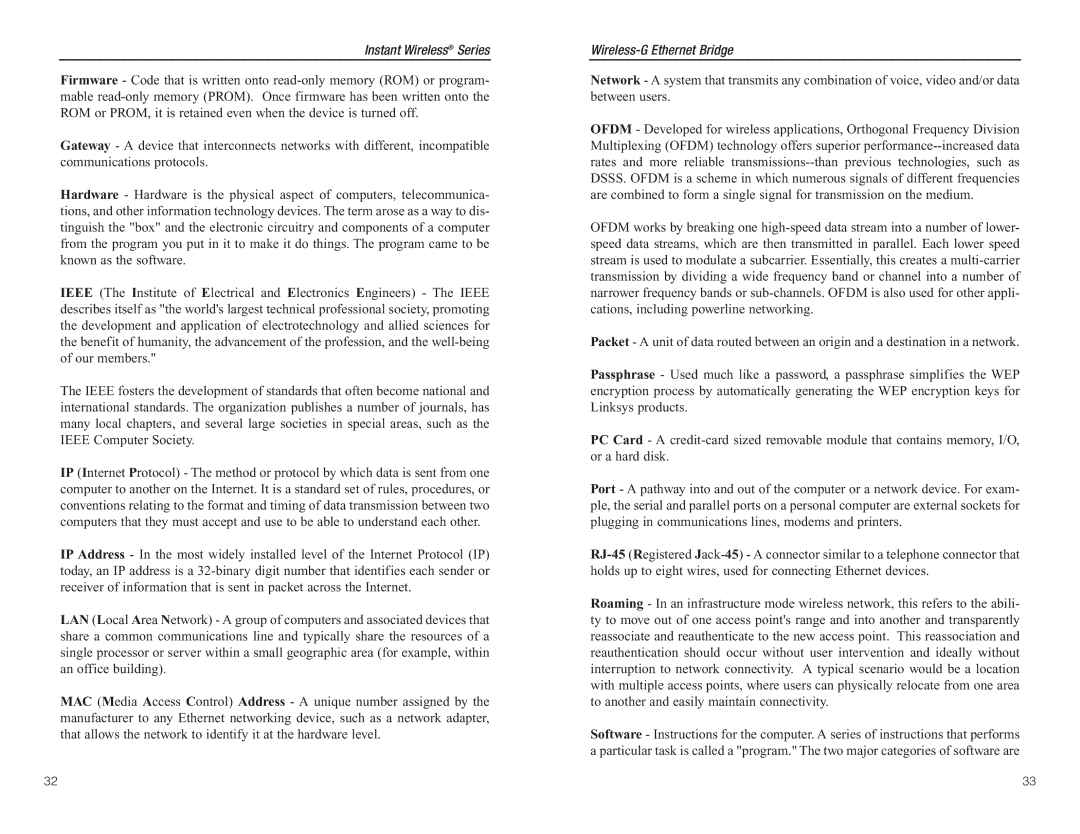Instant Wireless® Series
Firmware - Code that is written onto
Gateway - A device that interconnects networks with different, incompatible communications protocols.
Hardware - Hardware is the physical aspect of computers, telecommunica- tions, and other information technology devices. The term arose as a way to dis- tinguish the "box" and the electronic circuitry and components of a computer from the program you put in it to make it do things. The program came to be known as the software.
IEEE (The Institute of Electrical and Electronics Engineers) - The IEEE describes itself as "the world's largest technical professional society, promoting the development and application of electrotechnology and allied sciences for the benefit of humanity, the advancement of the profession, and the
The IEEE fosters the development of standards that often become national and international standards. The organization publishes a number of journals, has many local chapters, and several large societies in special areas, such as the IEEE Computer Society.
IP (Internet Protocol) - The method or protocol by which data is sent from one computer to another on the Internet. It is a standard set of rules, procedures, or conventions relating to the format and timing of data transmission between two computers that they must accept and use to be able to understand each other.
IP Address - In the most widely installed level of the Internet Protocol (IP) today, an IP address is a
LAN (Local Area Network) - A group of computers and associated devices that share a common communications line and typically share the resources of a single processor or server within a small geographic area (for example, within an office building).
MAC (Media Access Control) Address - A unique number assigned by the manufacturer to any Ethernet networking device, such as a network adapter, that allows the network to identify it at the hardware level.
Network - A system that transmits any combination of voice, video and/or data between users.
OFDM - Developed for wireless applications, Orthogonal Frequency Division Multiplexing (OFDM) technology offers superior
OFDM works by breaking one
Packet - A unit of data routed between an origin and a destination in a network.
Passphrase - Used much like a password, a passphrase simplifies the WEP encryption process by automatically generating the WEP encryption keys for Linksys products.
PC Card - A
Port - A pathway into and out of the computer or a network device. For exam- ple, the serial and parallel ports on a personal computer are external sockets for plugging in communications lines, modems and printers.
Roaming - In an infrastructure mode wireless network, this refers to the abili- ty to move out of one access point's range and into another and transparently reassociate and reauthenticate to the new access point. This reassociation and reauthentication should occur without user intervention and ideally without interruption to network connectivity. A typical scenario would be a location with multiple access points, where users can physically relocate from one area to another and easily maintain connectivity.
Software - Instructions for the computer. A series of instructions that performs a particular task is called a "program." The two major categories of software are
32 | 33 |
